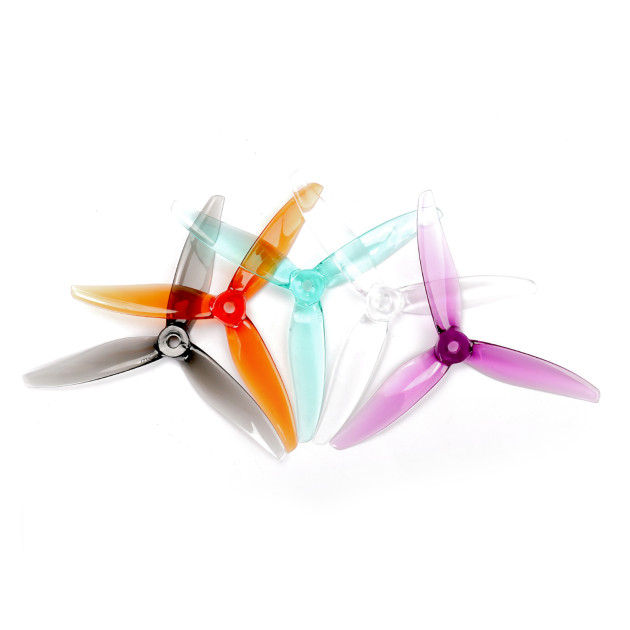Propeller
The propeller is a key component of every drone, fundamentally affecting its performance, handling, efficiency, and flight character. The frame and motors are usually chosen to match the prop — its diameter, pitch, and blade count. These three core parameters are typically readable directly from the prop’s label.
Naming conventions vary by manufacturer — for example, Gemfan uses formats like 5046 or 51477, where the first two digits indicate the diameter in inches (5″) and the remaining digits the pitch (4.6″ or 4.77″). HQProp uses 5×4.3×3, i.e., diameter × pitch × blade count. The prefix T denotes two M2 screws (T-mount). The world of props is fairly complex, so this tutorial uses simplified explanations of the most important principles.

A prop works much like an aircraft wing. On an airplane, lift is generated by air flowing around the wing as the aircraft moves forward. On a propeller, airflow is produced by the prop’s rotation. A larger diameter is like a longer “wing,” producing more lift. Higher pitch means a higher angle of attack (more blade tilt) and therefore more thrust. Higher RPM increases airflow around the blades and thus total thrust. Because the prop rotates about its centre, the tip speed rises towards the blade tips, which is why the blade profile changes from hub to tip.
Prop size (diameter)
Prop size states its diameter. From 2″ upward it’s given in inches, while the smallest tinywhoops use millimetres (e.g., 31 mm = 1.2″, 40 mm = 1.6″, 45 mm = 1.8″). A larger prop generally has a larger lift-producing area. For the same thrust, a larger prop needs fewer RPM than a smaller one. On the other hand, a larger prop has higher moment of inertia, reacts more slowly, and requires stronger motors.
As a rule of thumb, larger, slower-spinning props are more efficient, while smaller, high-RPM props give better dynamics and acceleration. That’s why racing and freestyle quads tend to use smaller props (e.g., 5″) at high RPM, whereas long-range builds favour larger props (e.g., 7″) for efficient, stable flight.
Prop pitch
Pitch indicates how many inches a prop would theoretically advance in one revolution if it were moving through a solid material. For example, a 5046 prop has 5″ diameter and 4.6″ pitch. A higher-pitch prop has steeper blades and a higher angle of attack. It generates more lift and thrust (up to a point) at the cost of higher consumption and worse low-throttle dynamics (e.g., in hover).
When flying forward, the prop “sees” both rotation-induced airflow and the oncoming airstream from the drone’s motion, so the effective inflow angle changes. Full-size aircraft therefore use variable-pitch props adapted to speed. FPV drones have fixed pitch, so you must choose based on your typical flight style. Higher pitch suits fast flying and racing (higher top speed). Lower pitch gives better low-speed control, preferred for freestyle and cinematic.
Blade count
Blade count sets the total lifting area (number of “wings”) and thus the thrust potential. More blades can make more thrust, but also increase drag and motor load.
Two-blade props are the most efficient, with low consumption, low inertia, and allowing very high RPM. They offer less static thrust and can be more vibration-prone. They suit long-range, light toothpicks and speed builds, where efficiency and snappy response matter.

Three-blade props are the universal choice balancing thrust, efficiency, and stability. They are by far the most common in FPV and used on most freestyle and racing quads.

Four-blade and higher props provide high static thrust even at lower RPM, useful for slower, stable flight. They are less efficient with a lower max speed. Most common on heavy cinewhoops where maximum thrust is needed.

Prop materials
Material choice strongly affects behaviour. The most common is polypropylene (PP) — a tough, flexible plastic that absorbs impacts and resists cracking. Thanks to its toughness it’s the most widely used FPV prop material. For larger/heavier drones, where PP would be too soft, carbon-fibre reinforced nylon (carbon-nylon) is used — stiffer and better at handling high loads. It’s typical on 7″ and larger cine-lifter props. Full carbon props are used on professional/industrial drones — light, stiff, efficient and precise, but brittle and potentially hazardous on contact, so they’re uncommon on hobby FPV quads.
Other prop characteristics
Also consider prop weight and blade width. Lighter props respond faster but may deform or damage more easily. Wider blades produce more area and thrust at the cost of higher motor load (similar trade-off as blade count).
Last but not least, ensure the prop’s mounting matches your motor. We covered mounting types in the motors chapter.
Selecting a prop is always a compromise between speed, thrust, efficiency, and handling. We recommend experimenting — flight feel can differ even between props of the same size from different brands.
